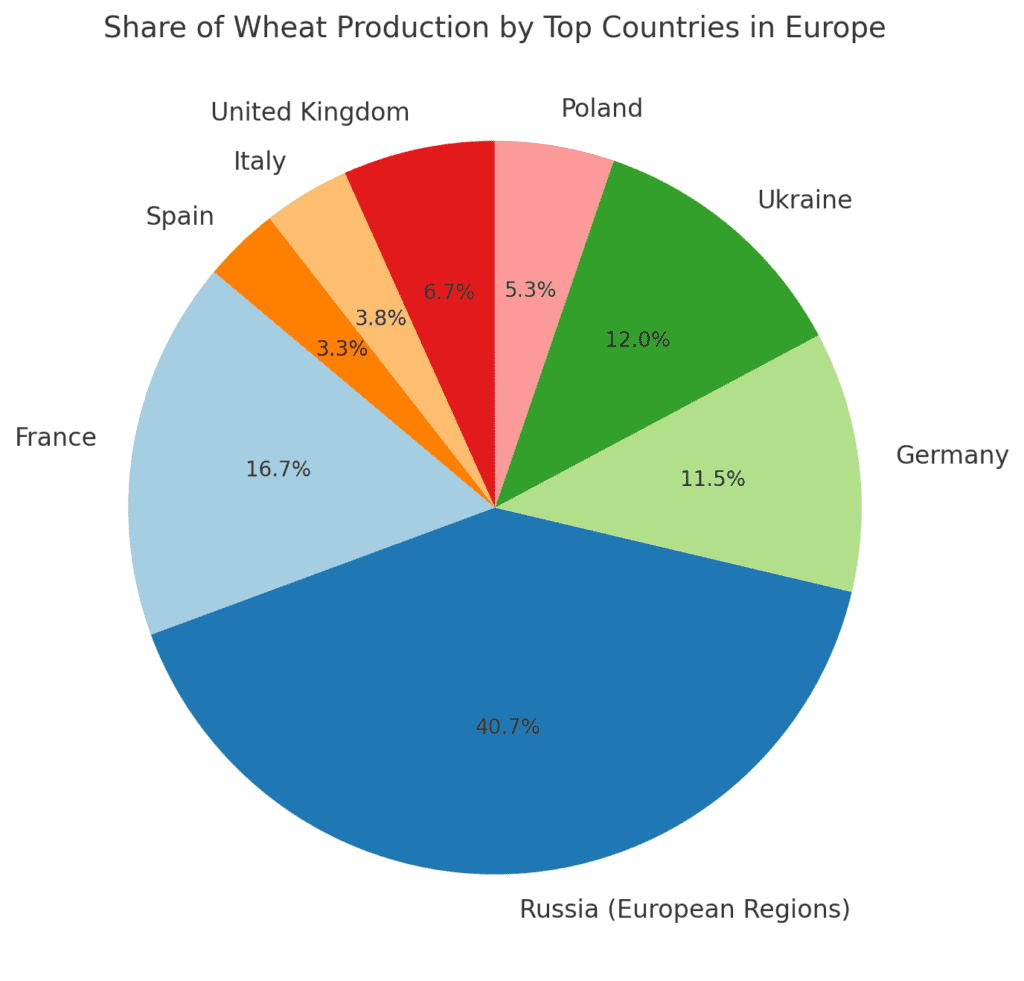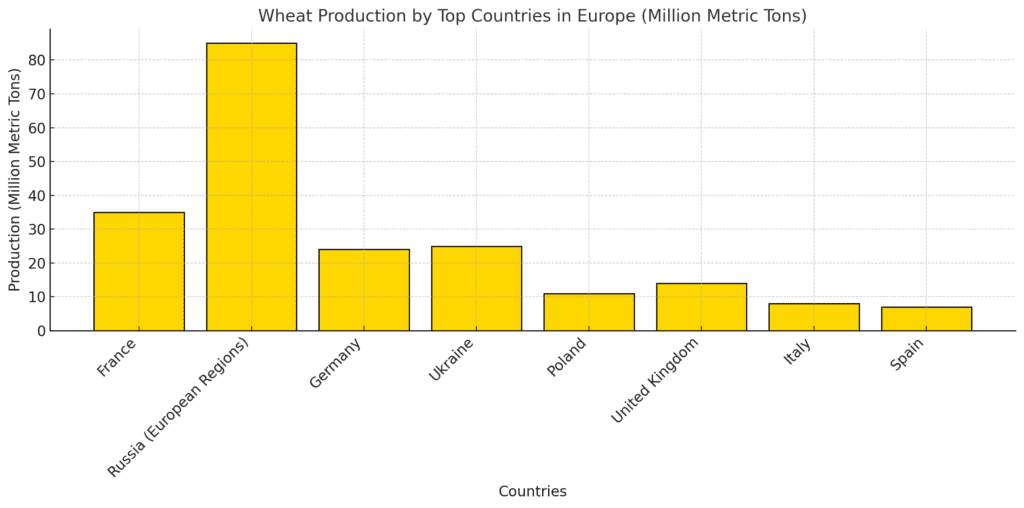Europe is a significant player in global wheat production, with several countries contributing to the continent’s agricultural success. Wheat is a staple crop across Europe, vital for both domestic consumption and international trade. This article explores the largest wheat-producing countries in Europe, their contributions, and the advancements shaping the sector.
🚀 Supercharge Your Insights with ESS Pro
Access over 50,000 expert market reports and connect with more than 500,000 verified industry contacts across the global food & beverage value chain.
Includes exclusive insights, top 10 rankings, live market indicators, and up to 10 custom research reports annually.
🔓 Join ESS Pro – Unlock Full Access

1. France: Europe’s Wheat Powerhouse
France leads Europe in wheat production, thanks to its fertile soils and favorable climate.
- Annual Production: Approximately 35 million metric tons.
- Key Regions: Île-de-France, Centre-Val de Loire, and Grand Est.
- Wheat Varieties: Soft wheat primarily for bread and pastries.
- Innovations: Use of precision agriculture and high-yield wheat varieties.
- Significance: A major exporter to North Africa and the Middle East.
2. Russia: A Global Wheat Leader
Although Russia spans Europe and Asia, its European regions are vital for wheat production.
- Annual Production: Over 85 million metric tons (total), with significant output from European regions.
- Key Regions: Krasnodar Krai, Rostov Oblast, and Stavropol Krai.
- Wheat Varieties: Hard red and soft white wheat.
- Innovations: Adoption of mechanized farming and drought-resistant crops.
- Significance: The world’s largest wheat exporter, supplying markets in Africa and Asia.
3. Germany: A Key Player in Europe’s Wheat Industry
Germany is a major wheat producer, known for its efficient farming practices.
- Annual Production: Around 24 million metric tons.
- Key Regions: Bavaria, Lower Saxony, and North Rhine-Westphalia.
- Wheat Varieties: Winter wheat for bread, beer, and animal feed.
- Innovations: Focus on sustainable farming and crop rotation.
- Significance: Supplies wheat to domestic markets and neighboring countries.
4. Ukraine: The Breadbasket of Europe
Ukraine is a top wheat producer, benefiting from its fertile black soils.
- Annual Production: Approximately 25 million metric tons.
- Key Regions: Odessa, Dnipropetrovsk, and Kharkiv.
- Wheat Varieties: Hard and soft wheat for bread and industrial uses.
- Innovations: Investments in modern irrigation and mechanization.
- Significance: A critical supplier to global wheat markets, despite recent challenges.
5. Poland: An Emerging Wheat Producer
Poland has steadily increased its wheat production, becoming a notable player in Europe.
- Annual Production: Around 11 million metric tons.
- Key Regions: Greater Poland, Mazovia, and Lower Silesia.
- Wheat Varieties: Winter wheat for flour and feed.
- Innovations: Adoption of organic farming practices and high-efficiency machinery.
- Significance: Exports wheat to neighboring European countries.
6. United Kingdom: Quality Over Quantity
The UK focuses on high-quality wheat production, often for specialized markets.
- Annual Production: Approximately 14 million metric tons.
- Key Regions: East Anglia, South East England, and Yorkshire.
- Wheat Varieties: Soft wheat for biscuits and bread.
- Innovations: Integration of AI in farming and sustainable practices.
- Significance: Supplies premium wheat to domestic and European markets.
7. Italy: Wheat for Pasta and Bread
Italy is a key producer of durum wheat, essential for pasta production.
- Annual Production: Around 8 million metric tons.
- Key Regions: Apulia, Sicily, and Emilia-Romagna.
- Wheat Varieties: Durum wheat for pasta and soft wheat for bread.
- Innovations: Use of traditional farming techniques alongside modern equipment.
- Significance: Italy’s wheat is vital for its culinary heritage and exports.
8. Spain: A Growing Wheat Market
Spain is an emerging wheat producer, with an emphasis on soft wheat varieties.
- Annual Production: Approximately 7 million metric tons.
- Key Regions: Castile and León, Andalusia, and Aragon.
- Wheat Varieties: Soft wheat for bread and pastries.
- Innovations: Emphasis on water-efficient farming techniques.
- Significance: Supplies wheat to Mediterranean markets.

Innovations Driving Wheat Production in Europe
European wheat producers are adopting several key innovations to enhance productivity:
- Precision Agriculture: GPS and drones for monitoring crop health and optimizing yields.
- Sustainable Practices: Crop rotation, organic farming, and water conservation.
- Advanced Seeds: Development of pest-resistant and drought-tolerant wheat varieties.
- Mechanization: Use of modern equipment for efficient planting and harvesting.
Challenges in European Wheat Production
Despite its strengths, the European wheat industry faces several challenges:
- Climate Change: Unpredictable weather patterns threaten yields.
- Soil Degradation: Overuse of fertilizers and monoculture farming impact soil health.
- Geopolitical Issues: Conflicts and trade restrictions affect exports.
Conclusion
Europe’s largest wheat-producing countries, including France, Russia, and Germany, are central to the continent’s agricultural economy and global food supply. By leveraging advanced technologies and sustainable practices, these nations continue to lead in wheat production, ensuring food security and economic growth.



